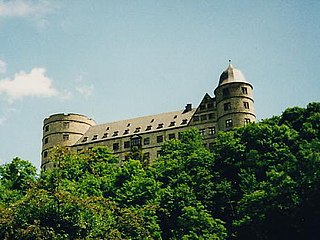
Wewelsburg is a Renaissance castle located in the village of Wewelsburg, which is a district of the town of Büren, Westphalia, in the Landkreis of Paderborn in the northeast of North Rhine-Westphalia, Germany. The castle has a triangular layout, with three round towers connected by massive walls. After 1934, it was used by the SS under Heinrich Himmler, and was to be expanded into a complex which would serve as the central SS cult-site.

Karl Maria Wiligut was an Austrian Völkisch occultist and soldier. He served in the Austro-Hungarian Army during World War I and was a leading figure in the Irminism movement, eventually joining the SS after being recruited by Heinrich Himmler.

Totenkopf is the German word for skull. The word is often used to denote a figurative, graphic or sculptural symbol, common in Western culture, consisting of the representation of a human skull – usually frontal, more rarely in profile with or without the mandible. In some cases, other human skeletal parts may be added, often including two crossed long bones (femurs) depicted below or behind the skull. The human skull is an internationally used symbol for death, the defiance of death, danger, or the dead, as well as piracy or toxicity.

The uniforms and insignia of the Schutzstaffel (SS) served to distinguish its Nazi paramilitary ranks between 1925 and 1945 from the ranks of the Wehrmacht, the German state, and the Nazi Party.
SS-Verfügungstruppe was formed in 1934 as combat troops for the Nazi Party (NSDAP). On 17 August 1938 Adolf Hitler decreed that the SS-VT was neither a part of the Ordnungspolizei nor the Wehrmacht, but military-trained men at the disposal of the Führer. In time of war, the SS-VT were to be placed at the disposal of the army.
Fascist symbolism is the use of certain images and symbols which are designed to represent aspects of fascism. These include national symbols of historical importance, goals, and political policies. The best-known are the fasces, which was the original symbol of fascism, and the swastika of Nazism.

Emil Maurice was an early member of the National Socialist German Workers' Party and a founding member of the Schutzstaffel (SS). He was Hitler's first personal chauffeur, and was one of several persons of mixed Jewish and ethnic German ancestry to serve in the SS.
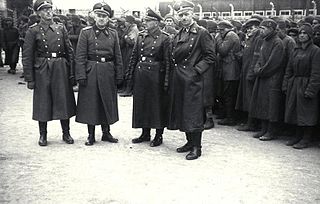
SS-Totenkopfverbände was a major branch of the Nazi Party's paramilitary Schutzstaffel (SS) organisation. It was responsible for administering the Nazi concentration camps and extermination camps for Nazi Germany, among similar duties. It was both the successor and expanded organisation to the SS-Wachverbände formed in 1933. While the Totenkopf was the universal cap badge of the SS, the SS-TV also wore this insignia on the right collar tab to distinguish itself from other SS formations.

Ariosophy and Armanism are esoteric ideological systems that were largely developed by Jörg Lanz von Liebenfels and Guido von List, respectively, in Austria between 1890 and 1930. The term 'Ariosophy', which translates to wisdom of the Aryans, was invented by Lanz von Liebenfels in 1915, and during the 1920s, it became the name of his doctrine. For research on the topic, such as Nicholas Goodrick-Clarke's book The Occult Roots of Nazism, the term 'Ariosophy' is generically used to describe the Aryan/esoteric theories which constituted a subset of the 'Völkische Bewegung'. This broader use of the word is retrospective and it was not generally current among the esotericists themselves. List actually called his doctrine 'Armanism', while Lanz used the terms 'Theozoology' and 'Ario-Christianity' before the First World War.

The Black Sun is a type of sun wheel symbol originating in Nazi Germany and later employed by neo-Nazis and other far-right individuals and groups. The symbol's design consists of twelve radial sig runes, similar to the symbols employed by the SS in their logo. It first appeared in Nazi Germany as a design element in a castle at Wewelsburg remodeled and expanded by the head of the SS, Heinrich Himmler, which he intended to be a center for the SS.

The 20th-century German Nazi Party made extensive use of graphic symbols, especially the swastika, notably in the form of the swastika flag, which became the co-national flag of Nazi Germany in 1933, and the sole national flag in 1935. A very similar flag had represented the Party beginning in 1920.

Hermann August Fredrich Priess was a German general in the Waffen-SS and a war criminal during World War II. He commanded the SS Division Totenkopf following the death of Theodor Eicke in February 1943. On 30 October 1944 he was appointed commander of the I SS Panzer Corps and led it during the Battle of the Bulge.
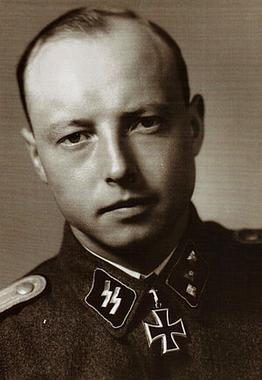
Heinz Macher was a mid-ranking Waffen-SS member and Nazi official during the Second World War. He served as the second personal assistant to Reichsführer-SS Heinrich Himmler.
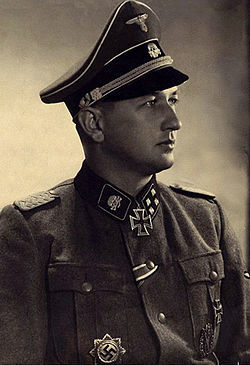
Otto Baum was a high-ranking commander (Oberführer) of the Waffen-SS during World War II. He was a recipient of the Knight's Cross of the Iron Cross with Oak Leaves and Swords of Nazi Germany.
Historians, political scientists and philosophers have studied Nazism with a specific focus on its religious and pseudo-religious aspects. It has been debated whether Nazism would constitute a political religion, and there has also been research on the millenarian, messianic, and occult or esoteric aspects of Nazism.
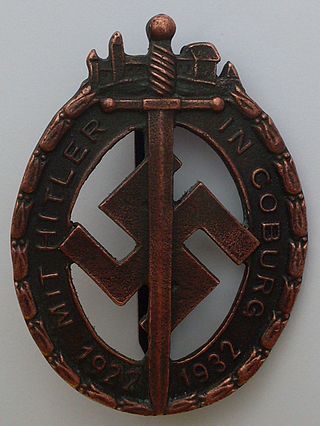
The Coburg Badge was the first badge recognised as a national award of the Nazi Party (NSDAP). Subsequently, it formally was given precedence as the highest Party award.
Runic alphabets have seen numerous uses since the 18th-century Viking revival, in Scandinavian Romantic nationalism (Gothicismus) and Germanic occultism in the 19th century, and in the context of the Fantasy genre and of Germanic Neopaganism in the 20th century.
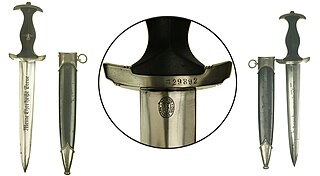
The SS-Ehrendolch was a ceremonial weapon of the Schutzstaffel (SS).
Ernst-Günther Krätschmer was a German SS-officer. After World War II he took part in efforts to shape a positive image of the Waffen-SS in popular culture. He published about the Knight's Cross recipients of the Waffen-SS, contributed to the publications of the HIAG, the revisionist veterans' organisation of the Waffen-SS, and organized support for Walter Reder, who was being imprisoned in Italy for war crimes.

Siegfried Taubert was a Nazi, SS-Obergruppenführer and General of the Waffen-SS. From 1935 to 1938 Taubert was chief of staff in Reinhard Heydrich's Sicherheitsdienst in the main SS office. From 1938 to 1945 he was the captain of the SS at Wewelsburg castle, which was Heinrich Himmler's SS headquarters and training center for head SS officers. Taubert died in Kiel in 1946.

















